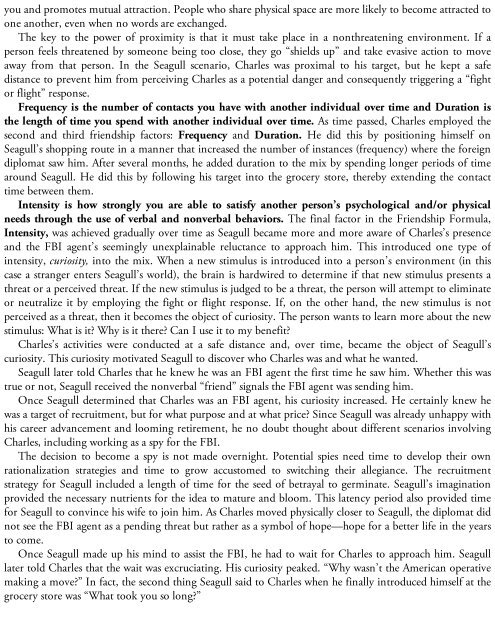[DR_The_Like_Switch
You also want an ePaper? Increase the reach of your titles
YUMPU automatically turns print PDFs into web optimized ePapers that Google loves.
you and promotes mutual attraction. People who share physical space are more likely to become attracted to<br />
one another, even when no words are exchanged.<br />
<strong>The</strong> key to the power of proximity is that it must take place in a nonthreatening environment. If a<br />
person feels threatened by someone being too close, they go “shields up” and take evasive action to move<br />
away from that person. In the Seagull scenario, Charles was proximal to his target, but he kept a safe<br />
distance to prevent him from perceiving Charles as a potential danger and consequently triggering a “fight<br />
or flight” response.<br />
Frequency is the number of contacts you have with another individual over time and Duration is<br />
the length of time you spend with another individual over time. As time passed, Charles employed the<br />
second and third friendship factors: Frequency and Duration. He did this by positioning himself on<br />
Seagull’s shopping route in a manner that increased the number of instances (frequency) where the foreign<br />
diplomat saw him. After several months, he added duration to the mix by spending longer periods of time<br />
around Seagull. He did this by following his target into the grocery store, thereby extending the contact<br />
time between them.<br />
Intensity is how strongly you are able to satisfy another person’s psychological and/or physical<br />
needs through the use of verbal and nonverbal behaviors. <strong>The</strong> final factor in the Friendship Formula,<br />
Intensity, was achieved gradually over time as Seagull became more and more aware of Charles’s presence<br />
and the FBI agent’s seemingly unexplainable reluctance to approach him. This introduced one type of<br />
intensity, curiosity, into the mix. When a new stimulus is introduced into a person’s environment (in this<br />
case a stranger enters Seagull’s world), the brain is hardwired to determine if that new stimulus presents a<br />
threat or a perceived threat. If the new stimulus is judged to be a threat, the person will attempt to eliminate<br />
or neutralize it by employing the fight or flight response. If, on the other hand, the new stimulus is not<br />
perceived as a threat, then it becomes the object of curiosity. <strong>The</strong> person wants to learn more about the new<br />
stimulus: What is it? Why is it there? Can I use it to my benefit?<br />
Charles’s activities were conducted at a safe distance and, over time, became the object of Seagull’s<br />
curiosity. This curiosity motivated Seagull to discover who Charles was and what he wanted.<br />
Seagull later told Charles that he knew he was an FBI agent the first time he saw him. Whether this was<br />
true or not, Seagull received the nonverbal “friend” signals the FBI agent was sending him.<br />
Once Seagull determined that Charles was an FBI agent, his curiosity increased. He certainly knew he<br />
was a target of recruitment, but for what purpose and at what price? Since Seagull was already unhappy with<br />
his career advancement and looming retirement, he no doubt thought about different scenarios involving<br />
Charles, including working as a spy for the FBI.<br />
<strong>The</strong> decision to become a spy is not made overnight. Potential spies need time to develop their own<br />
rationalization strategies and time to grow accustomed to switching their allegiance. <strong>The</strong> recruitment<br />
strategy for Seagull included a length of time for the seed of betrayal to germinate. Seagull’s imagination<br />
provided the necessary nutrients for the idea to mature and bloom. This latency period also provided time<br />
for Seagull to convince his wife to join him. As Charles moved physically closer to Seagull, the diplomat did<br />
not see the FBI agent as a pending threat but rather as a symbol of hope—hope for a better life in the years<br />
to come.<br />
Once Seagull made up his mind to assist the FBI, he had to wait for Charles to approach him. Seagull<br />
later told Charles that the wait was excruciating. His curiosity peaked. “Why wasn’t the American operative<br />
making a move?” In fact, the second thing Seagull said to Charles when he finally introduced himself at the<br />
grocery store was “What took you so long?”


